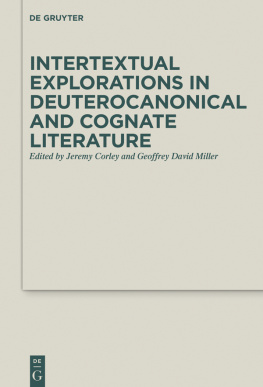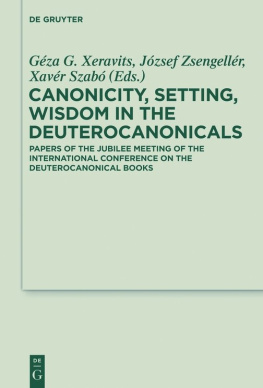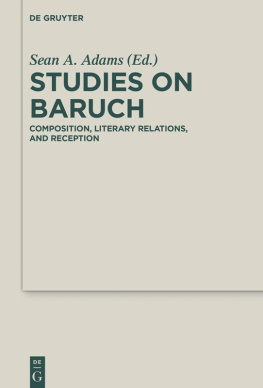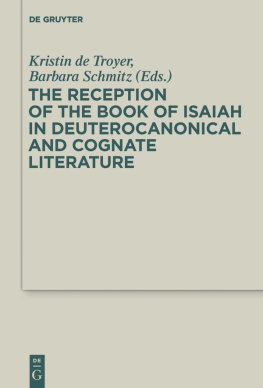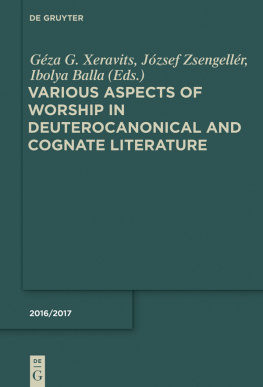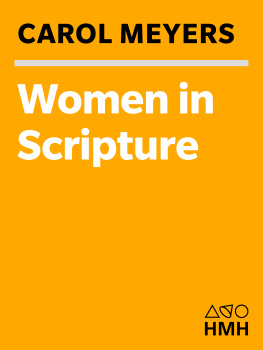Contents
Guide

Intertextual Explorations in Deuterocanonical and Cognate Literature
Deuterocanonical and Cognate Literature Studies

Edited by
Friedrich V. Reiterer, Beate Ego,
Tobias Nicklas and Kristin de Troyer
Volume 31

ISBN 978-3-11-041592-6
e-ISBN (PDF) 978-3-11-041693-0
e-ISBN (EPUB) 978-3-11-041695-4
ISSN 1865-1666
Library of Congress Cataloging in Publication Control Number: 2019932240
Bibliographic information published by the Deutsche Nationalbibliothek
The Deutsche Nationalbibliothek lists this publication in the Deutsche Nationalbibliografie; detailed bibliographic data are available on the Internet at http://dnb.dnb.de.
2019 Walter de Gruyter GmbH, Berlin/Boston
www.degruyter.com
Geoffrey David Miller and Jeremy Corley
Encountering Intertextuality in Deuterocanonical and Cognate Literature
Within the field of biblical studies, the last three decades have witnessed a surge of monographs and articles applying intertextual readings to diverse texts from the Old and New Testaments. uterocanonical books, as well as in related texts such as Second Baruch, Fourth Ezra and the Prayer of Manasseh. The present introduction has several aims. First, it will propose a methodological distinction between author-oriented and reader-oriented intertextuality. Second, it will consider briefly some methodological criteria for author-oriented intertextuality, with discussion of levels of prominence and types of connection within such intertextual analysis. Third, it will summarize some recent intertextual scholarship on the deuterocanonical books. Finally, it will provide an overview of the essays in the present volume.
This volume represents the culmination of work arising out of several meetings of the Deuterocanonical Books Continuing Seminar at the Annual Meeting of the Catholic Biblical Association of America. For a few years, more than a dozen scholars employed a variety of approaches to examine some intertextual links between these texts and other literature, both biblical and non-biblical. Many of the essays included here examine intertextuality in a diachronic manner, arguing that a later writing borrowed from one or more precursor texts to adapt traditional material for a new audience. A few other essays look at the reception of deuterocanonical and cognate texts in later contexts such as the New Testament or rabbinic Judaism. Still other essays study intertextuality irrespective of chronology by reading two or more texts in tandem, in order to explore a particular theme or understand the function of a certain genre.
Intertextual study of the deuterocanonical books and related literature can be done in diverse ways yielding a variety of results. This diversity of approaches has led to a wealth of knowledge and insight into these texts, but it has done little to clarify the methodological vagueness in the field. Among scholars today, the word intertextuality has become a rather plastic term, signifying different things to different people. For some, it connotes the identification of sources that influenced a later text; for others it implies the study of two or more texts simultaneously irrespective of chronology and authorial intent; and for still others the word is laden with strong semiotic overtones borrowed from post-modern literary theory, requiring a different type of reading than is normally practiced in biblical studies. The present volume attempts to address some of this ambiguity by classifying the essays according to chronological focus. The first section contains studies that read texts in conjunction with earlier ones, the second pertains to roughly contemporaneous texts, and the third looks forward to the reception of earlier texts by later ones. This tripartite division seeks to bring some clarity to the plurality of approaches to intertextual study.
In addition to dealing with a topic of current scholarly interest, this volume also provides a somewhat comprehensive coverage. The six longest deuterocanonical books are all represented in this volume (though not the Additions to Daniel, Esther, or Jeremiah), while 4 Ezra, 2 Baruch, and the Prayer of Manasseh are also discussed. The volume also evinces a diversity of approaches, and concludes with a methodological discussion of recent intertextual studies along with recommendations for future research on the topic. Researchers interested in many of the ways that intertextuality has been investigated by biblical scholars will hopefully find this volume to be a useful resource.
One: Distinction between Author-Oriented and Reader-Oriented Intertextuality
The term intertextuality is usually derived from the literary-critical work of Julia Kristeva, and has been developed by literary critics such as Harold Bloom, Roland Barthes, and Jonathan Culler.
Some scholars argue that perceived connections between two or more texts are intentional and signal to readers that they should interpret one text in light of the other (author-oriented approach), while others claim that authorial intent is irrelevant, leaving readers free to identify any connections they wish and to construe this intertextual relationship as they deem fit (reader-oriented approach). The author-oriented approach is more widely represented in the biblical field than the reader-oriented approach.
The two methodologies may be briefly contrasted. The reader-oriented approach is a synchronic form of study in which the reader supplies the meaning, whereas the author-oriented approach is a diachronic form of analysis in which the author has already provided the meaning, reinterpreting or alluding to an earlier text. The reader-oriented approach views all texts as interdependent (at least potentially), whereas the author-oriented approach usually focuses on a small number of texts regarded as being relevant because of their close relationship. While the reader-oriented approach considers a texts meaning as inexhaustible, the author-oriented approach often seeks to define a fixed or limited meaning, excluding some other meanings as impossible or improbable. Many theorists of literature and culture, such as Kristeva, Bakhtin, Barthes, and Ben-Porat, have advocated the reader-oriented approach.
On the one hand, a reader-oriented approach accepts that a fruitful way to make sense of a text is through connections to other texts, even if such connections are unintended and even unknown to the original author. Such an approach has the effect of decentering another text, or sometimes even denying it; for instance, the sympathy for non-Jews evident in the Books of Jonah or
On the other hand, an author-oriented form of intertextuality implies a deliberate use of an earlier text for various purposes. For instance, the new composition can seek to explicate a prior text, as in Wis 11:616, which offers midrashic explanations of the first plague against Egypt (Exodus 7) and the gift of life-giving water at Horeb (Exodus 17), as well as the plagues involving animals in relation to Egyptian animal worship (Exodus 710). Such an author-oriented use of intertextuality can show that the later composition is influenced by the earlier text and promotes its theology, to keep alive the older text and make its ideology relevant in a new context. For instance, the author of Tobit reflects Deuteronomys continued influence with its theology of the fear and love of God, the importance of the centralized cult, and a religious understanding of remembering, as well as the idea that Israels secure dwelling in Palestine is contingent on fidelity to the Law of Moses.

